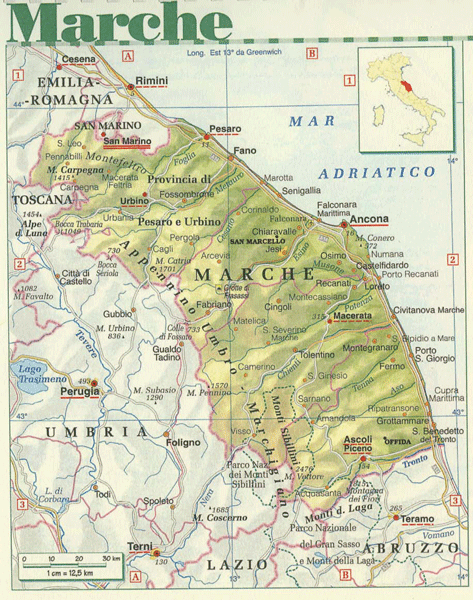
For the gastronomic traveler, there are reasons enough to visit Marché (pronounced Mar´kay). From the culinary point-of-view, Marche is a little more sophisticated than Molise or Abruzzo, sharing borders and culinary traditions with Emilia-Romana and Tuscany, as well as with Umbria and Abruzzo.
Marché comprises an area just 50 miles tall by 30 miles wide. It ranks 15th among Italy’s regions in size, and 13th in population (1,400,000). It’s a countryside of rolling hills blanketed with vineyards (75,000 acres under vine), small hilltop towns, walled Medieval cities, a beautiful coastline, and some underground caverns that are alone worth a visit to the area. Time seems slower here. There is no hustle and bustle, and the cleanliness of its little towns rivals that of Switzerland.
Archeological evidence shows that grape vines have been tended here for over 3,000 years. But it’s not so easy to characterize the nature of the area, because the personality of the wines changes from north to south and east to west.
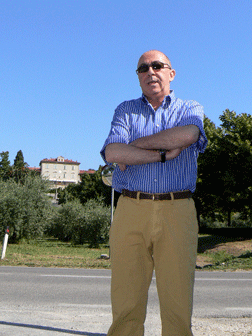
Count Saladini Pilastri, with his villa in the background
Traveling northward from Abruzzo on the coast-hugging A14 autostrada, you pass into Marché at the Tronto River. Do not take the autostradatoward Ascoli Piceno. Instead, continue north a mile or so until you come to National Road 4, a slower, more bucolic two-lane road that connects the Porto d’Ascoli at the coast, with Ascoli Piceno 17 miles upstream. This is an area that was brought under Papal rule in the 1600’s. Towns on the south side of the river were allied with the Kingdom of the Two Sicilies, those on the north side of the river with the Pope. Ascoli Piceno with a medieval center, gives its name to both Rosso Piceno (a red blend of Montepulciano and Sangiovese), and to Falerio dei colli Ascolani (a white wine blend of the local varieties, Pecorino, Passerina, and Trebbiano, with sometimes the addition of a little Chardonnay).
The National Road 4 skirts the base of the hills, upon which grow vineyards and orchards. As all over Italy, for purposes of defense, the towns were perched on the tops of the hills. In the vicinity of Spinétoli, a town founded by Romans, you’ll pass the gently sloping vineyards and imposing villa of Count Saladini Pilastri. The 800-acre estate, half of which is planted to vines, is the largest single property in the Piceno hills. The owner is descended from two families that united over 1,000 years ago, and his title derives from an ancestor who fought in the Crusades. At 60,000 cases, Saladini Pilastri is perhaps the largest organic winery in Italy. The vineyards, stretching over 9 kilometers (5.5 miles), are planted to Sangiovese, Montepulciano, Merlot, Syrah, Cabernet Sauvignon, and Aglianico for the reds, Passerina, Pecorino, Trebbiano and Chardonnay for the whites, as well as some small experimental plantings. You can visit the winery with an appointment, or stop by the tasting room, which is just across the road from the villa (circa 1800). There is also a “filling station” here where locals fill their jugs with generic red or white wine. While the winery is probably best known for its Rosso Piceno blend of Sangiovese and Montepulciano, I was most taken with the white wines from indigenous grapes. The Saladini Pilsatri Falerio is a wine of subtle complexity, with floral and mineral notes. The single varietal, Pecorino, is citrusy, with great minerality, vibrancy and roundness, as well as a slight salty tang. The winery also produces the proprietarily named Pregio el Conté, an unusual blend of Fiano and Falanghina, two rather obscure grapes from southern Italy. These wines all represent excellent value.
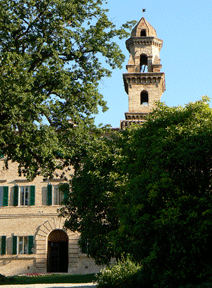
The main house of Seghetti Panichi, and the bell tower of the oratory
For the Epicurean Traveler the place to stay (if you can afford it) is the Borgo Storico Seghetti Panichi, a few miles west of Saladini Pilastri. Borgo is the Italian equivalent of “borough” or “burg” and often refers to a new town built outside the walls of the old town, which in this case is Castel di Lama. The buildings of the Borgo sit on a hilltop overlooking the Tronto Valley, which was for hundreds of years the border between competing dynasties. There is evidence on the site of fortifications dating to the 1300s. The main residence is the result of a late 17th – early 18th century renovation, resulting in a brick mansion of three floors around a central gallery, above vaulted cellars. An earlier watchtower was incorporated into the building, from which a secret escape tunnel leads to the 16th century chapel, or oratory. Today the mansion is divided into five luxury suites, ranging in price from $130 to $900 a night, depending on the room and time of year. The mansion is surrounded by a park designed by German botanist Ludwig Winter in 1875, which includes a pond, palm trees, oaks and other exotic plants. Tours of the historic gardens are guided by Princess Giulia Panichi Pignatelli.
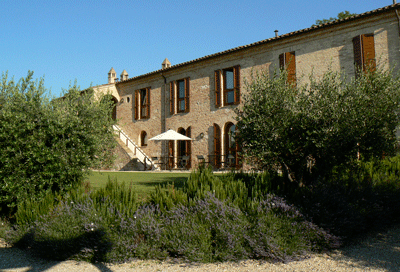
The Seghetti Panichi farmouse
Below the chapel, a 16th century farmhouse has been renovated into Ristorante La Quintana. The restaurant specializes in updated Marché recipes, and serves as the venue for cooking classes led by Beatrice del Balzo Panichi. The red brick building also contains five beautifully appointed suites with marble bathrooms, kitchenettes, air-conditioning, living rooms downstairs and sleeping quarters upstairs. With sweeping views over the lawn and swimming pool to the valley below, the sea to the east and massive mountains to the west, these suites go for $130 to $650 a night, including buffet breakfast and VAT tax.

Filippo Panichi
Guests can arrange for a tour of the family winery and vineyards led by the very passionate Filippo Panichi, who has renovated and commercialized the family winery. From 28 hectares (69 acres) of vineyards grown on the hills around Castel di Lama, Filippo makes wines typical of the area: Rosso Piceno, Falerio, and single varietals of Pecorino and Passerina. His top-of-the-line wine, called Rubens, is a red wine blend (the grape varieties have changed over the vintages) that retails at the winery for just $11, while the rest of the Filippo Panichi line retails for less than $7 at the winery.
Five miles west of Castel di Lama, as the terrain rises into the mountains, you’ll come to Ascoli Piceno, surrounded on three sides by mountains. This city of 52,000 predates the founding of Rome. It has a splendid medieval center, including more than 50 ancient towers, built entirely from the local travertine marble. Within the city limits a 13 hectare (32 acre) vineyard slopes down to the 90,000 case Velenosi winery (apropos of nothing, but an interesting side fact, is that velenosi is the Italian word for “poisonous” ). Since Angela and Ercole Velenosi founded the winery in 1984, Velenosi has grown to become
the most ambitious winery of southern Marché, and to my mind the most consistently outstanding. They farm 100 hectares (250 acres) of grapes between Ascoli Piceno and the coastal city of Ancona, and additionally buy grapes for the production of a non-oaked Montepulciano d’Abruzzo.
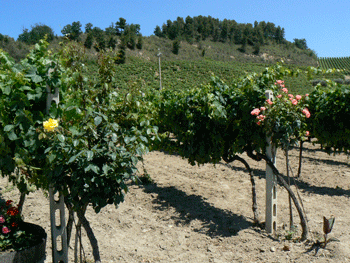
Velenosi’s vineyard at the winery in Ascoli Piceno
Like Illuminati in the Abruzzo hills across the river, Velenosi creates a full line of wines, fromtraditional sparkling wine made from Pinot Noir and Chardonnay, to reds, whites and even a local historical blend of red grape and sour cherry wine. However, they excel at interpreting wines from
the indigenous grapes across the breadth of Marché. Velenosi makes three versions of Rosso Piceno, of which Roggio del Filare Rosso Piceno Superiore is particularly worth seeking out. Another red, Lacrima di Morro, comes from vineyards in the municipality of Ancona. The whites include Passerina (including a Charmat sparkling version), Pecorino, Falerio, Chardonnay, and Verdicchio from the Esino valley 40 miles to the north.
Verdicchio is grown in two zones following the Esino River in the middle of Marche. For the epicurean traveler, this area is made to order, as several wineries have restaurants associated with them. Until recently, when one spoke of the wines of Marche, one was speaking primarily of Verdicchio, because although there are now 15 D.O.C. designated wines and 10 different grape varieties allowed in Marche, Verdicchio still represents the greatest production.
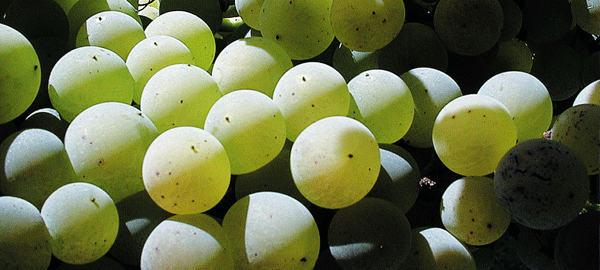
Verdicchio grapes, indigenous to Marché
Though up to 15% of other grapes are allowed by law, most Verdicchio (it’s pronounced Vair-deek´-eeo) is made entirely from Verdicchio grapes. A white variety that has been grown here since at least 1413, Verdicchio is (in its modern incarnation) semi-aromatic, delicate, crisp and well-structured, with lime-like fruit enhanced by mineral and candied citrus peel flavors. Those used to big oaky Chardonnays will probably find their first sip of Verdicchio a bit underwhelming. By the second glass, however, they’ll wonder how a wine so subtle could at the same time be so complex. It wasn’t always that way; it’s a grape that required modern technology to bring out the best in it. As a result it was not much appreciated outside the local area until about 30 years ago.
Because the area is dedicated to just one grape variety, wine producers try to make it in a range of styles from still to sparkling, from dry to sweet, from barrel fermented to stainless steel fermented. In the U.S. you’ll find mostly the dry, still version. Fazi-Battaglia, a 300,000 case winery under the guidance of consulting winemaker Franco Bernabei, is the largest exporter with its famous dowager-shaped bottle.
Seven producers and more than 200 small growers are clustered in a high valley running south to north, in the mountains around Matelico, a town that dates from the 12th and 13th centuries. This high valley is the center of production for Verdicchio of the Verdicchio di Matelica D.O.C., which accounts for about 10% of Verdicchio production. It’s the only north/south facing valley in the Marche. It snows in the winter, it’s cold in the spring and very hot in the summer, with large swings between daytime and nighttime temperatures, a fact which allows the grapes to ripen fully while maintaining crisp acidity. According to Roberto Potentini, enologist from Belisario winery, the past decade has seen a lot of experimentation in both the vineyards and in the wineries to create more complex wines. Belisario, one of two cooperative wineries and the largest of the seven Matelica producers, is named for the Byzantine General who founded some of the local villages.
Chef proprietor Emanuela Della Mora of Villa Marchese del Grillo Ristorante-Enoteca (restaurant and wine bar) in Fabriano in the upper valley, shows off the local cuisine’s varied influences from the Venetian-style stuffed, batter-fried olives, to the more Tuscan style Tagliatelli with porcini mushrooms in olive oil and sage, or the rabbit stuffed with wild fennel. The restaurant, housed in a Villa that was built in 1771, has a wine cellar with over 600 labels from which to choose.
From Matelica the river runs north about 20 miles before turning northeast, sloping from about 1500 feet above sea level down to the Adriatic sea a few miles north of the coastal city of Ancona, Marche’s largest city, with 100,000 people. Wines from the Castelli di Jesi appellation in the lower valley account for 90% of Verdicchio production.
Cupramontana, on the south side of the valley, is a typical hilltop town in Marché, and it’s a good place to start on your wine excursion, as it’s in the historic center of Verdicchio production. Wine has been produced here for thousands of years. If you’re interested in graphic art, the international wine label museum will be an interesting diversion. On the way to the museum, one late autumnal morning I strolled up the middle of the narrow mainstreet, listening for the sound of approaching cars that would require a retreat to the curb, when it struck me that there was no sound of any traffic, not even the constant susserant whisper of distant traffic, no wind rustling leaves, no dogs barking, no music, no conversation. It was, I think, the quietest place I’ve ever been.
If you’d rather not stop, follow the main road through town and just after you crest the hill you’ll come to the 23,000-case Vallerosa Bonci winery and vineyard. The farm now consists of 125 acres (87 under vine), grown at an average altitude of 1350 feet. The Bonci family has been in the area since the 17th century, and wine has always been made at the farm, but it wasn’t until the 1920’s that the family started making wine for sale. Today the winery is worth a visit not only for its very good wines, but for an outstanding wine museum that displays traditional winemaking equipment.
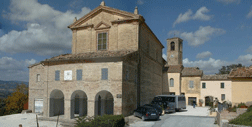
Antiche Fonti della Romita
After visiting Vallerosa Bonci, you’ll want to make a stop at the restored Romita monastery nearby. Owned by the Colonnara cooperative winery in Cupramontana, the 800 year old building nowhouses a hotel, a tasting room where you can sample Colonnara’s wines, and the Antiche Fonti della Romita restaurant that features the typical fare from the land of the Marche, from truffles and local cave-aged sheep cheese, salami, lamb, rabbit, poultry and pork, as well as from the Adriatic sea for fresh fish and shellfish.
A cooperative of 184 growers, Colonnara makes some of the very best wine in the area. Despite its appeal as a fresh young wine, some of Colonnara’s older vintages we tasted attest to the wine’s durability, and suggest they can age and improve for 7 to 10 years.
Le Busche Ristorante in Montecarotto, in the hills north of the river, is a 90 seat formal restaurant in the middle of a large vineyard owned by the Moncaro cooperative winery. Drawing on the creative inspiration of locally born chef Andrea Angeletti, the restaurant earned one Michelin star in 2003. The dishes are combinations of traditional ingredients fancifully presented, with some oriental influences and modern cooking techniques. The menu, which is heavily weighted toward seafood, includes such fare as tagliolini with eel and squash flower, or fried shrimp in a sweet-sour sauce. The wine list is not limited to wines of the cooperative, but includes 60 Verdicchios and over 300 wines from Italy and France, as well as a good selection of Cognac, Calvados and single malt scotch. Moncaro, incidentally, has three wineries in Marche: One in Montecarotto in the heart of Verdicchio country, one on the slopes of Mount Conero, and one in Ascoli Piceno. Their best wines are presented under the Terre Cortesi label.
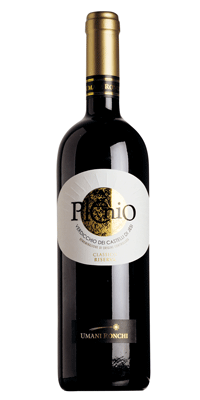
La Torre Hotel Ristorante & Pizzeria in the town of Castelbellino, just across the road fromUmani Ronchi’s original winery in lower Esino valley is a casual affair, presenting 54 different types of pizza, and pasta with pizzaz, including my favorite lasagna of all time — thin homemade lasagna noodles layered with fresh local cheese and béchamel sauce, which is perfectly suited to pairing with Verdicchio.
Umani Ronchi’s tasting room at Villa Bianchi can be found across the river in the town of Moie. Umani Ronchi’s Verdicchio Riserva, called Plenio, is consistently one of the best. The winery owns 210 hectares (450 acres), with 12 vineyards scattered through Marche and Abruzzo.
The Esino empties into the Adriatic just above Ancona, and it would be worth your while to try two of the red wines from the area. The aforementioned Lacrima di Morro, made from Lacrima di Morro d’Alba grapes, is a dense, fruit-forward wine from Ancona. But the area’s most outstanding red is Rosso Conero (pronounced with the emphasis on the first syllable – Cone´-ero), from the slopes of Mount Conero. My personal favorite Rosso Conero is Alessandro Moroder’sriserva called Dorico. The 12,000 case Moroder Winery and vineyards are perched 750 feet above the Adriatic, in the hamlet of Montacuto, in the heart of the Mount Conero Nature Reserve, where the family has lived since the 18th century. With help from famed consulting winemaker, Franco Bernabei, Alessandro and Serenella Moroder have spent the past three decades perfecting this wine. Moroder’s Rosso Conero is made entirely from Montepulciano grapes, and displays elegance and restraint without sacrificing intensity of flavor. Buy a bottle at the winery and enjoy the spectacular view.
Umani Ronchi also produces a fine Rosso Conero Riserva called Cumaro. If you happen to be traveling on May 31st, the day many private wineries open their doors to the public, it would be worth a side trip to visit the architecturally stunning, modern, underground barrel cellar at Umani Ronchi’s 300,000 case winery in Osimo, a few miles inland from Mount Conero.
SIDE TRIPS
Marché is rich untapped territory for the tourist with a car. Two of the more rewarding side trips are Corinaldo and Frasassi Le Grotte, or Frasassi Caverns.
Corinaldo is a small hilltop town of 5,000, but the historic center is contained within its well-preserved 14th century walls, where 500 of Corinaldo’s inhabitants still reside in Medieval and Renaissance buildings. In 1517 the inhabitants of the city resisted the siege of the Duchi Delle Rovere, an event that is celebrated each year on the third Sunday of July with a pageant and period costumes. Several 18th century churches are also worth visiting. Market day, of interest to anyone looking for a bargain, as well as those looking to peruse the local produce, is held each Wednesday.
The Frasassi Caverns are not to be missed and are, in themselves, worth the four hour drive from Rome. It’s just a 25 minute drive from Ancona. Local spelunkers discovered the system of underground caverns in the 1950’s. The government has subsequently developed the caves for tourism, with paths and judiciously placed lights to illuminate the stalagmites, stalactites and fantastic mineral deposits that have taken 1,400,000 years to form. The largest of the caverns could hold the entire Milan cathedral with room to spare.
WHERE TO STAY IN MARCHE
Borgo Storico Seghetti Panichi
Tel: 39 0736 812552
Fax: 39 0736 814528
Email: info@seghettipanichi.it
www.seghettipanichi.it
 The Seghetti Panichi farmouse |
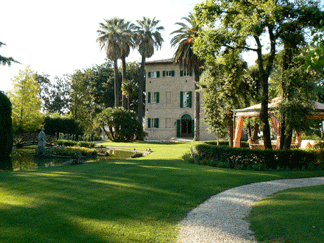
|
|
Borgo Storico Seghetti Panichi
|
|
WHERE TO EAT IN MARCHE
Ristorante Antiche Fonti della Romita, Cupramontana, Italy
Via Eremo della Romita 8, Cupramontana 60034
Tel: 39 0731789979
Fax: 39 0731789979
 |
|
Ristorante Antiche Fonti della Romita
|
Ristorante Le Busche
Busche via 2 60036 Montecarotto AN
Tel: 39 0731/89172
Fax: 0731/899140
Email: info@lebusche.net
www.lebusche.net
Closed Sunday evening and Monday all day. 50 and covered outdoor tables.
 |
|
View from Le Busche restaurant on the Moncaro Estate
|
Il Marchese del Grillo
Via Rocchetta Low, 73 Fabriano
Tel 0732.625690
Email: info@marchesedelgrillo.com
www.marchesedelgrillo.com
Note: Closed Sunday evening and Monday
Ristorante La Quintana
Beatrice del Balzo Panichi
Tel: 39 0736 812211
Fax: 39 736 814528
WINERIES TO VISIT IN MARCHE
Colonnara
Via Mandriole, 2
60034, Cupramontana (AN), Italia
Tel: 39 0731 780273
Fax: 39 0731 789610
info@colonnara.it
Saladini Pilastri
5, Saladini street
Spinetoli 63036 (AP)
Tel: 39 0736 899534
Fax: 39 0736 898594
Email: info@saladinipilastri.it
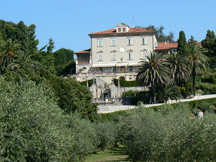
Villa Saladini Pilastri
Moncaro winery
Via Piandole, 7/a
60036 Montecarotto (AN)
Tel: 39 0731 89245
Fax: 39 0731 89237
http://www.moncaro.com
Cantina Seghetti Panichi
Filippo Panichi
Tel: 30 0736 815339
Fax: 39 0736 812096
Email: info@filippopanichi.it
Umani Ronchi Spa
Via Adriatica, 12 60027 Osimo (an) ITALY
Tel: +39 0717108019
Fax: +39 0717108859
www.umanironchi.com
Velenosi
Angela Velenosi
Via dei Biancospini, 11-63100
Ascoli Piceno
Tel: 39 0736 341218
Fax: 39 0736 346706
Email: info@velenosivini.com
www.velenosivini.com
Villarosa Bonci
Via Torre, 15/17, Cupramontana (An) – ITALIA
Tel: +39 0731 789129
Fax: +39 0731 789808
http://www.vallerosa-bonci.com
& & &
